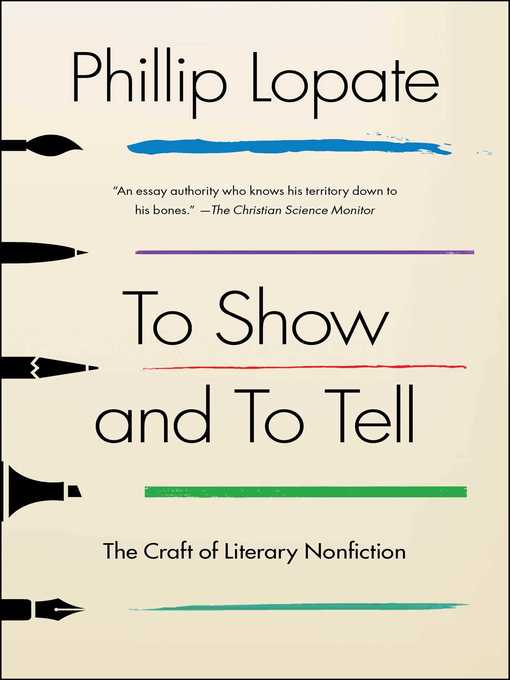
To Show and to Tell
The Craft of Literary Nonfiction
کتاب های مرتبط
- اطلاعات
- نقد و بررسی
- دیدگاه کاربران
نقد و بررسی

November 15, 2012
One of the Earls of Essay returns with a collection that illustrates both his knowledge of the genre and his considerable skill in practicing it. Some of these pieces have appeared earlier, and they range in nature from struggles to define the genre, to pedagogical strategies he's tried (and recommends), to reviews of the essays of other writers--living (Ben Yagoda, whose chin is the target for some Lopate left hooks) and not (Lamb, Hazlitt, James Baldwin). Lopate (Graduate Nonfiction/Columbia Univ.; At the End of the Day: Selected Poems and an Introductory Essay, 2010, etc.) is both at ease and ill at ease with the definitions of "creative nonfiction," "memoir" and "lyric essay," and he continually revisits his discomfort. He confesses that he's neither a philosopher nor a professional rhetorician, so he sometimes has difficulty articulating precisely what he means. Most readers will disagree. Lopate also repeatedly uses moments from his own classroom to illuminate his points, mentioning struggles that students have finding a "voice," defining the "I" they will use, figuring out how to organize and how to end a personal essay. He urges all to ignite the curiosity and follow its flames. In the piece "The Essay: Exploration or Argument?" he somewhat softens his earlier view that the personal essay contains no argument. We learn that he's kept a journal since age 17 and that he recognizes, though grates, at the lower status nonfiction inhabits in academe. He takes a little poke at Facebook (though he fears no real evil from it) and expresses great admiration for Emerson and Baldwin, "the most important American essayist since the end of World War II." A useful collection of bracing thoughts and sinuous sentences.
COPYRIGHT(2012) Kirkus Reviews, ALL RIGHTS RESERVED.

February 1, 2013
Lopate (director, graduate nonfiction program, Columbia Univ.; The Art of the Personal Essay) offers here another title in what seems to be a whirlwind of recent publishing on creative nonfiction. His discussions and opinions primarily concern the personal essay as representative of the wider genre of literary nonfiction. Lopate is particularly successful in probing the psychological aspects of such factual, intimate writing. His advice is as ruminative and open-ended as the writing style he seeks to draw out of his students, a more philosophical and thought-provoking take on the craft of literary nonfiction than can be found in most of the other choices on this subject. The first part, "The Craft of Personal Narrative," contains the bulk of the text. Section two, "Studies of Practitioners," covers Lopate's favorite essayists, including Charles Lamb, Edward Hoagland, and James Baldwin. VERDICT Writers and teachers of the personal essay will certainly want this title. Others with a broader interest in literary nonfiction may opt for works presenting more of an overview, such as Tracy Kidder and Richard Todd's Good Prose: The Art of Nonfiction or Lee Gutkind's Creative Nonfiction: How To Live It and Write It. [See Prepub Alert, 8/24/12.]--Stacey Rae Brownlie, Harrisburg Area Comm. Coll. Lib., Lancaster, PA
Copyright 2013 Library Journal, LLC Used with permission.

February 15, 2013
Lopate, a consummate and piquant essayist and director of Columbia University's graduate nonfiction program, draws on his extensive teaching experience in this expert, anecdotal, funny, and frank guide to writing intelligent, satisfying, engaging literary nonfiction. Even in a how-to book, Lopate can't help but write lithe and sparring personal essays, so we learn, for example, that he honed his chops as a ghostwriter. His sophisticated advice touches on psychological challenges as much as craft, such as when he names self-hatred as a stumbling block for writers, and, admitting his own audacity when writing about family and friends, instructs memoirists to be prepared to accept the guilt when people get upset. He also suggests developing a tone of assertion. Lopate draws helpful comparisons with fiction, noting that nonfiction also requires conflict and the art of characterization but that its story line is a thought process. Never one to accept received wisdom, Lopate encourages writers to go beyond the safe, facile, and sentimental. To see him practice what he preaches, turn to his newest essay collection, Portraits inside My Head.(Reprinted with permission of Booklist, copyright 2013, American Library Association.)

























دیدگاه کاربران